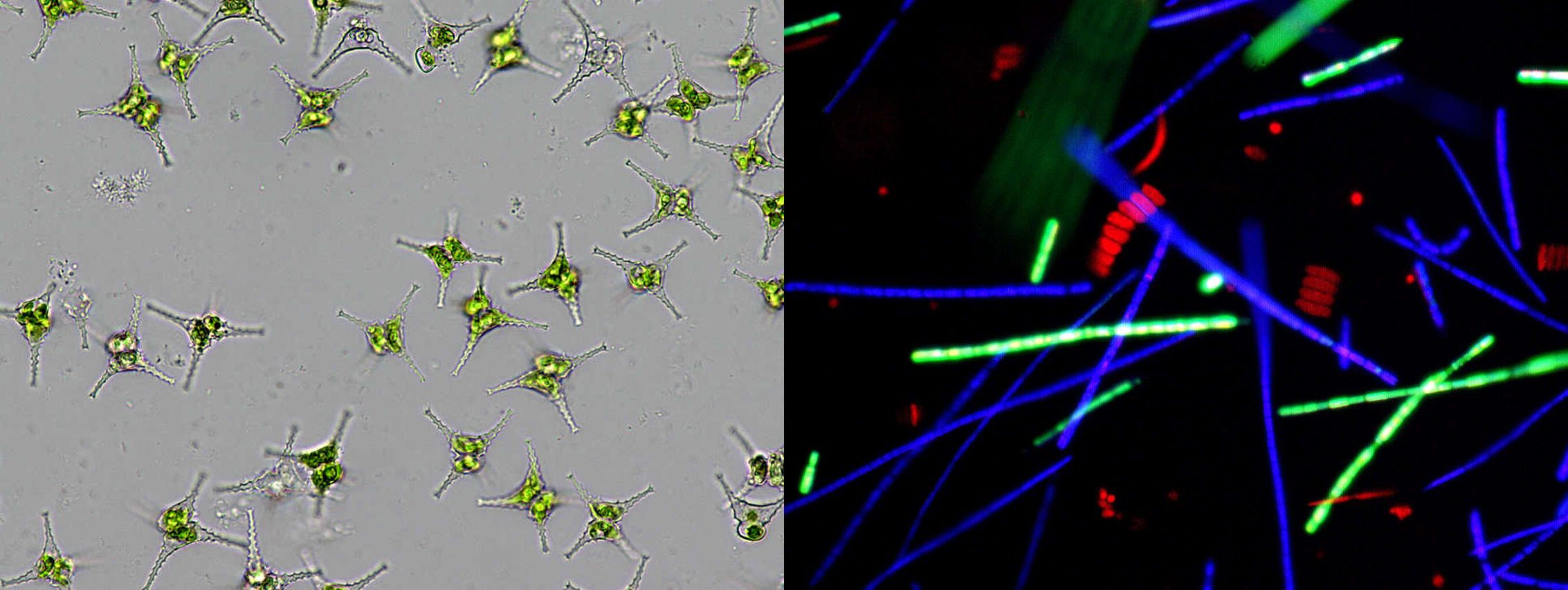Custom Solution (IAP) > Use Cases > Microalgae & cyanobacteria cell count
Microalgae culture techniques & management optimization
Microalgae have, in recent years, attracted much interest worldwide, as they are an important source of oils and other biomolecules that can be used in the production of biofuels, biopharmaceuticals, cosmetics, biofertilizers, and food ingredients.
However, the use of microalgae is still not economically viable, as just the costs of harvesting microalgae – which largely depends on the type of microalgae used, the type of cultivation system, and the separation method – are estimated to account for roughly 20-30% of the total production cost.
The image recognition technology developed by Oculyze can be adapted to quickly and accurately do cell counts and asses microalgae viability (using fluorescence microscopy), potentially speeding up the production process, while also reducing costs.
Being able to do frequent cell counts is essential for understanding the adaptive responses of microalgae to various environmental factors (such as, for instance, exposure to microplastics). It is also paramount for biofuel production methods using cell disruption to facilitate the release of intracellular products, which requires monitoring the reduction in the intact cell count.

But let’s dig deeper into how to grow microalgae, the most used microalgae culture techniques, and what are microalgae used for.
The difference between microalgae and macroalgae
As the name suggests, microalgae are merely algae that are not visible to the naked eye. They are unicellular and their size typically ranges from just a few micrometers to a few hundred micrometers. Macroalgae, on the other hand, commonly referred to as seaweeds, are larger and can be seen and identified by the human eye.
Are cyanobacteria algae?
Microalgae and cyanobacteria and inextricably linked in the sense that collectively they create what we refer to as phytoplankton, the base of the food web. Also, just like microalgae, cyanobacteria obtain energy through photosynthesis. And, as with microalgae, these photosynthetic pathways have also been exploited for the generation of renewable energy. Despite all these similarities, though, there is also a significant difference between the two: cyanobacteria are a type of bacteria, not algae.
Nevertheless, due to their color (“kuanós” in Greek means “blue”), the fact that they contain a chloroplast, and their closeness to microalgae on the same trophic level, cyanobacteria are commonly referred to as blue-green algae.
Microalgae culture techniques
There are currently several microalgae culture techniques, each with its advantages and downsides, from the photobioreactors and the open pond systems to the air lift method and the fermentor-type reactors.
To improve the economics of the process, several pathways are still being explored, one of the most promising being using wastewater as a culture medium. The big advantage of this approach would be the reduction in cost and freshwater requirements, but the microalgae also assimilate the metals and nutrients from the wastewater, potentially playing a significant role in the wastewater treatment phase.
What are microalgae and cyanobacteria used for
Blue green algae vs spirulina
First off, it should be pointed out that there is a constant (understandable) wave of mistrust and reluctance towards any nutritional supplement or food ingredient based on cyanobacteria. After all, according to CDC’s FAQ sheet on cyanobacteria blooms,
“Harmful cyanobacteria blooms may affect people, animals, or the environment by:
- Blocking the sunlight that other organisms need to live. Cyanobacteria blooms can steal the oxygen and nutrients other organisms need to live.
- Making toxins, called cyanotoxins. Cyanotoxins are among the most powerful natural poisons known. They can make people, their pets, and other animals sick.”
Nevertheless, some of the most popular dietary supplements out there, spirulina, is merely a biomass of cyanobacteria suitable for human consumption, while chlorella, another nutritional supplement very popular in Japan is made from microalgae.
So microalgae and cyanobacteria (albeit only certain strains and in certain conditions) are indeed successfully and safely being used in the production of dietary supplements.
Staying in the realm of human nutrition, there is also quite a bit of experimenting happening with manipulating microalgae for the production of a type of protein with a lighter carbon footprint than that of conventional sources.
Bioactive chemical compounds in microalgae have also been isolated and then used for their beneficial properties in pharmaceuticals and cosmetics.
And, of course, cyanobacteria have been added to the soil for nitrogen fixation, thus acting as a biofertilizer.
But probably the most promising commercial application for microalgae is for biofuel production. Microalgae can store staggering amounts of oil (up to 80% of dry weight) which can be converted to fuel. However, the biggest challenge of microalgae biofuel is finding ways to decrease the operation costs, such as by speeding up lab work, optimizing the production process and increasing cell concentrations and the content of lipids, which, with the constant development of new technologies, might just be possible in the very near future.
If you want to learn more about how the Oculyze system can be used for optimizing the process of microalgae monitoring or you are interested in developing a custom solution for your business, contact us at [email protected]!
Sources:
- https://microbialcellfactories.biomedcentral.com/articles/10.1186/s12934-018-0879-x
- https://onlinelibrary.wiley.com/doi/10.1002/9781118567166.ch9
- https://www.google.com/url?sa=t&rct=j&q=&esrc=s&source=web&cd=&ved=2ahUKEwiby4merrn5AhUtPewKHU24Bd4QFnoECCAQAQ&url=https%3A%2F%2Fwww.mdpi.com%2F2071-1050%2F12%2F23%2F9980%2Fpdf&usg=AOvVaw1McPzOjoarrs7atR5kNHrZ
- https://www.mdpi.com/2311-5637/4/4/93/htm
- https://www.academia.edu/download/48654365/j.apenergy.2011.08.04820160907-13657-1wik25j.pdf
- https://www.sciencedirect.com/science/article/abs/pii/S0167779913000917
- https://www.google.com/url?sa=t&rct=j&q=&esrc=s&source=web&cd=&ved=2ahUKEwiDmef7zLn5AhXMm6QKHRqGDOEQFnoECBgQAw&url=https%3A%2F%2Fwww.cdc.gov%2Fhabs%2Fpdf%2Fcyanobacteria_faq.pdf&usg=AOvVaw0FmXfoQzH4_RWLZu7j0SJA
- https://bmcbiotechnol.biomedcentral.com/articles/10.1186/1472-6750-11-118